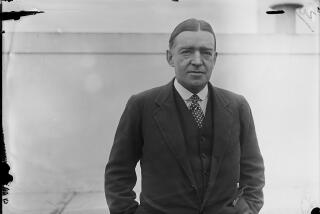Giant of Paleontology Who Connected With Bones, Not People
- Share via
Alas, poor Eugene Dubois! No one knew him well. A paleontologist whose greatest joy was to hold a skull and discern its evolutionary place (he once noticed the prominent forehead and lantern jaw of a waiter in a Paris restaurant and exclaimed, “Look at that skull! What I would give to have one like it for my collection!”), Dubois was a total failure at connecting with people. But with bones, he was a genius. He found what paleontologists now call Homo erectus, the missing fossil link in humans’ evolution from apes. To Dubois, it was Pithecanthropus erectus, or P.e.
Dubois’ story, long forgotten but now admirably unearthed by Pat Shipman and affectingly told in the present tense, makes the quests of Indiana Jones seem like a child’s stay at an adventure camp. Dubois is born in the Dutch province of Limburg in 1858, 18 months after the first Neanderthal skeletons are found in Germany--”the first tangible proof of human evolution,” Shipman writes--and the year before Charles Darwin publishes “The Origin of Species,” which “made the find comprehensible by placing it in a context.” Dubois sees these events as “gateposts through which he passed as he started down the path to his future.” Learning and study are his two principal pleasures, although his excellent physical fitness proves as critical to his later success as his intellect. And success is clearly on his mind from an early age. At 10, he vows “to discover a truth, a fact as solid and important as a brick, one that will last forever.”
Well, many 10-year-olds make similar vows; Dubois keeps his. Though he lives in a static European society that sees life as inherently preordained, he understands that evolution requires change, and “part of the attraction he feels to evolutionary theory results from its ability to upset the old order. . . . He is drawn to it with an almost religious fervor.” This fervor strips him of his Catholic upbringing and belief and is the cause of a painful break with his favorite sister Marie when she becomes a nun, for “she will be devoted to the Church, and he is bound over to Truth and Science.” It is but the first he has with virtually every important person in his life--including his two sons and even his wife, Anna. “Always your skulls and your bones,” she says to him one day. “Don’t you ever think about people?” Dubois does not hear her.
He hears only the siren call of the discovery that will change the world and make him famous. After careful study and logical reduction of the facts, he deduces that the East Indies (and specifically Sumatra) are the most reasonable place to look for the remains of ape-like men, or Pithecanthropi. Fortunately, the Indies (now part of Indonesia) are a Dutch colony. Dubois is commissioned as a physician, packs up Anna and their 6-month-old first child Eugenie (the only child who will not disappoint him), and after a six-week sail during which he becomes reasonably proficient in Malay, they arrive in Sumatra in December 1887.
*
Five years pass. The Missing Link is also missing in Sumatra, and the family moves to Java. Dubois is nearly killed by a collapsing cave, by a tiger and by malaria. But at a place along the Solo River called Trinil he finds the most promising site yet, though nothing else recommends it. “A few cool windy days seduced me into setting up my tent near the excavation,” he writes in his diary. “After a stay of 14 days I discover that there is no more unsuitable place available in Java, because of health and malaria, for the study of fossils than this hell (which I, being born a Roman Catholic, had mistaken for purgatory).” Another malaria attack leaves him feeling as if he will die there. Instead, he both recovers and is saved. A piece of skullcap, a femur and a tooth are found. They are neither fully ape nor fully human. The skull is largely simian but the thigh is part of an animal that walked upright. At his home on Christmas morning 1892, after examination and reexamination, he is certain. “It is done, Anna,” he says simply.
He searches for three more years (including a fruitless trip to India that might have been told shorter) but finds no more evidence of his ape-man, though he does accumulate 414 boxes of other fossils weighing 37,000 kilos. But only the three P.e. fossils really matter. Sailing home in the summer of 1895, the ship is tossed so severely in a storm that the captain loads the passengers into lifeboats. Dubois, sitting with Anna and their three children, suddenly realizes his three precious fossils are in the cabin. If the boat goes down, his proof will sink with it. He runs across the heaving deck and returns with his suitcase of bones. “If the lifeboat is lowered,” he says to Anna, “you see to the little ones, for I shall have to look after this.”
His return to the European scientific community is not triumphal. He convinces some scholars of the importance of his find, but not all. He becomes a paleontologic Ancient Mariner, going across Europe from scientific congress to scientific congress, laying out his facts and proofs. He does not help himself when he refuses to let others study his find lest they somehow steal his glory. Instead, he locks the bones away, “only sometimes in the afternoons if he is feeling melancholy--he extracts them--and once again is filled with wonder at the remarkable objects he has found.”
*
Dubois was determined to find P.e., and he did. Shipman, a paleontologist and fine writer whose other books include “Taking Wing,” and “The Evolution of Racism,” was equally determined to find Eugene Dubois, not least because “he single-handedly created the conceptual framework now used in the analysis of all fossil humanoid remains,” and she has. “The Man Who Found the Missing Link” is true to the science yet accessible to a general reader, and it is a captivating story of an obsession that changed the understanding of our species.






